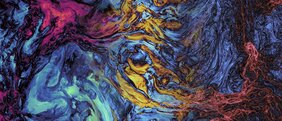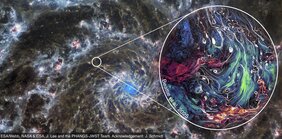Unveiling the Hidden Patterns of Cosmic Turbulence: New Study Maps the Magnetic Disorder of Interstellar Space
In a groundbreaking study led by an international team of researchers, including Ralf Klessen from the Center for Astronomy of Heidelberg University, has provided the most detailed view yet of how turbulence behaves in the magnetized interstellar medium (ISM) between the stars. For the first time they have quantitatively mapped the full range of turbulent energy across scales in a simulation of the ISM with unprecedented numerical resolution, taking into account its complex magnetic properties. The results offer key insights into processes that govern the structure and evolution of galaxies, including star formation, magnetic field dynamics, and the propagation of cosmic rays. The study, “The spectrum of magnetized turbulence in the interstellar medium,” has now been published in NATURE Astronomy.
Turbulence is a well-known phenomenon in everyday life. Anyone who has ever felt a bumpy airplane ride or watched smoke curl unpredictably from a flame has experienced turbulence - the chaotic, seemingly random motion in fluids like air or water.
But turbulence is not limited to our everyday world. It also fills the space between stars in our Galaxy, known as the interstellar medium (ISM), where it plays a crucial role in star formation, cosmic ray transport, and the structure of galactic magnetic fields.
The Challenges of Cosmic Turbulence
Unlike Earth-bound turbulence, turbulence in space occurs in a plasma, a hot, electrically charged gas, and is permeated and strongly affected by magnetic fields. This makes it particularly difficult to observe and model, what might be going on out there.
"By running and analyzing the world’s largest simulation of magnetized turbulence - designed to replicate galactic conditions - we have made unprecedented, high-precision measurements that reveal major deviations from canonical models", explains James Beattie from the Department of Astrophysical Sciences of Princeton University and Candian Institute for Theoretical Astrophysics of University of Toronto, and lead author of the study ."Notably, we find that a cornerstone of turbulence theory breaks down in the magnetized case and which represents a fundamental advance in our understanding of astrophysical, magnetized turbulence", Beattie rates the new findings.
A fundamental process in turbulence is the turbulent cascade where energy injected into a fluid or plasma at large scales is transferred step by step to smaller and smaller scales until it is eventually dissipated as heat. "The turbulent cascade in the ISM extends over many orders of magnitude, far greater than we expected to realistically model on a computer," explains Ralf Klessen, Heidelberg, expert on interstellar turbulence and co-author of the research paper.
The astrophysicist runs the Star Formation Research Group at Heidelberg University to identify and characterize the physical processes that govern the birth of stars at present days and in the early Universe.
Klessen rates the transition between supersonic and subsonic turbulence as particularly interesting. "The so-called sonic scale is an important parameter in our theoretical models of star formation. In this new calculation, we finally succeeded for the first time to resolve and describe this important transition in the presence of magnetic fields on a computer," Klessen enthusiastically explains.
Key Findings of the Study
What the astrophysicists find in their simulations only partially agrees with the predictions of models of magnetic supersonic turbulence and a new theoretical approach is needed. The team explicitly observed that magnetic fields alter the way energy cascades through the ISM, suppressing small-scale motions and enhancing certain wave-like disturbances known as Alfvén waves. Their findings also help explain how turbulence can simultaneously support gas clouds against gravitational collapse and locally induce the conditions necessary for star formation. The results also have implications for our understanding of cosmic ray transport, alignment of interstellar dust grains, and the interpretation of astronomical observations across the electromagnetic spectrum.
Technical Achievements
The team conducted simulations at Reynolds numbers exceeding one million, a record for this type of study. The Reynolds number is a dimensionless quantity that measures the ratio of inertial forces to viscous forces in a fluid flow; higher values indicate more turbulent flows.
The Reynolds number for blood flow is about 2000 which leads to the expectation of some turbulence in the center of the flow. For a blue whale moving through water it's a few million, meaning that inertial forces dominate over viscous forces and the whale's motion is largely governed by its large size and speed, rather than the water's viscosity.
Achieving such high Reynolds numbers allows for a more accurate representation of astrophysical turbulence. To achieve this, the simulation utilised over 80 million CPU hours distributed across nearly 140,000 compute cores on the high-performance supercomputer, SuperMUC-NG, at the Leibniz Supercomputing Centre. Reaching a spatial resolution of 10,080³ grid cells, the researchers explored how gas motions and magnetic fields interact within the interstellar medium.
Unlike many previous studies that assumed incompressible flows with a background, static magnetic field, the researchers included compressible turbulence and a magnetic field that was self-consistently generated by a dynamo - like the magnetic field around Earth or the Sun - where extremely strong density variations, shockwaves, and more realistic, chaotic magnetic fields sustained by the Galactic turbulence are present. This approach provides a more realistic model of astrophysical plasmas, which often exhibit supersonic flows.
The present calculation, and its analysis, opens up new avenues for understanding astrophysical turbulence and its statistical properties. These results will be incorporated into future models of star formation in the supersonic, turbulent, multiphase ISM.
Toward a More Complete Galactic Model
The new model provides a benchmark for computer simulations of galactic environments and helps refine models used in radio astronomy and space missions. It also supports the broader effort to understand how invisible forces - like magnetized turbulence - shape the visible structures of the Universe. “The interstellar medium may seem empty, but it’s a dynamic, turbulent environment,” says Christoph Federrath, from the Australian National University in Canberra, who is also deeply involved in this project. “We were able to characterize how turbulent energy is distributed from the largest galactic scales down to the scales where star formation begins,” his colleague Ralf Klessen adds. It became clear that our galaxy is not static, but a dynamic, turbulent environment, and the new study brings us a step closer to understanding the physical laws that govern it.
Implications for Astronomy
This is the first time such measurements have been made at this precision and at these scales. The results come at a time when there is increasing observational access to the ISM, and growing interest in understanding how turbulence shapes star formation and the evolution of galaxies. As new instruments come online, which will have the ability to measure the fluctuations in turbulent magnetic field in across the galaxy in great detail - such as the Square Kilometre Array - accurate theoretical predictions for magnetized turbulence can be tested through observations, potentially refining our comprehension of the structure and evolution of our cosmic home - the Milky Way.
ORIGINAL SCIENCE PUBLICATION
“The spectrum of magnetized turbulence in the interstellar medium”, published in NATURE Astronomy on May 13, 2025, DOI: 10.1038/s41550-025-02551-5.
Preprint on Arxiv: arxiv.org/pdf/2504.07136
ADDITIONAL INFORMATION
Access to Simulation Data
All raw simulation data for temporally-averaged energy spectra, probability distributions functions and structure functions presented in the study are available at the GitHub repository: github.com/AstroJames/10k_supersonicMHD.
The Star Formation Research Group at Heidelberg University
The primary research goal of this Research Group led by astrophysicist Prof. Dr. Ralf Klessen is to identify and characterize the physical processes that govern the birth of stars at present days and in the early universe. Scientific interests include gas dynamics and chemistry in the interstellar medium, formation and evolution of galaxies such as the Milky Way, astrophysical turbulence, magnetic fields and dynamo processes, stellar dynamics, design and optimization of numerical algorithms in computational astrophysics, as well as development and application of modern machine learning methods. The research group is hosted at the Institute for Theoretical Astrophysics (ITA), which is part of the Center for Astronomy of Heidelberg (ZAH) University. For more information see www.klessen.org
Center for Astronomy of Heidelberg University
The Center for Astronomy of Heidelberg University is the largest university based astronomy group within Germany and joins the institutes Astronomisches Rechen-Institut (ARI), Landessternwarte Königstuhl (LSW) and Institut für Theoretische Astrophysik (ITA). Established in 2005, its spectrum of research and teaching activities ranges from planet formation and galaxy evolution to cosmology and state of the art computer physics in parallel with the development and assembly of instrumentation for telescopes and participation in satellite projects. More information is available from the center's research groups and its research collaborations. For more information see www.zah.uni-heidelberg.de.
Related information to the press
- University of Toronto: "Astrophysicists are exploring our galaxy’s magnetic turbulence in unprecedented detail using a new computer model"
- EurekAlert: Astrophysicists explore our galaxy’s magnetic turbulence in unprecedented detail using a new computer model
Useful Links
- COSMOS-Web project homepage
cosmos.astro.caltech.edu/page/cosmosweb - Center for Astronomy of Heidelberg University (ZAH)
zah.uni-heidelberg.de/welcome - Research homepage of Prof. Dr. Ralf Klessen
www.klessen.org - Research homepage of Dr. James Beattie
astrojames.github.io - Leibniz Supercomputing Centre
www.sc.lrz.de - Square Kilometre Array (SKA)
www.skao.int/en
SCIENTIFIC CONTACT
Prof. Dr. Ralf Klessen
Center for Astronomy of Heidelberg University (ZAH)
Institute for Theoretical Astrophysics (ITA)
klessen@uni-heidelberg.de
CONTACT FOR MEDIA INQUIRIES
Dr. Guido Thimm
Center for Astronomy of Heidelberg University (ZAH)
thimm@uni-heidelberg.de


